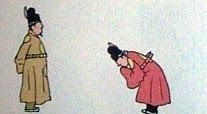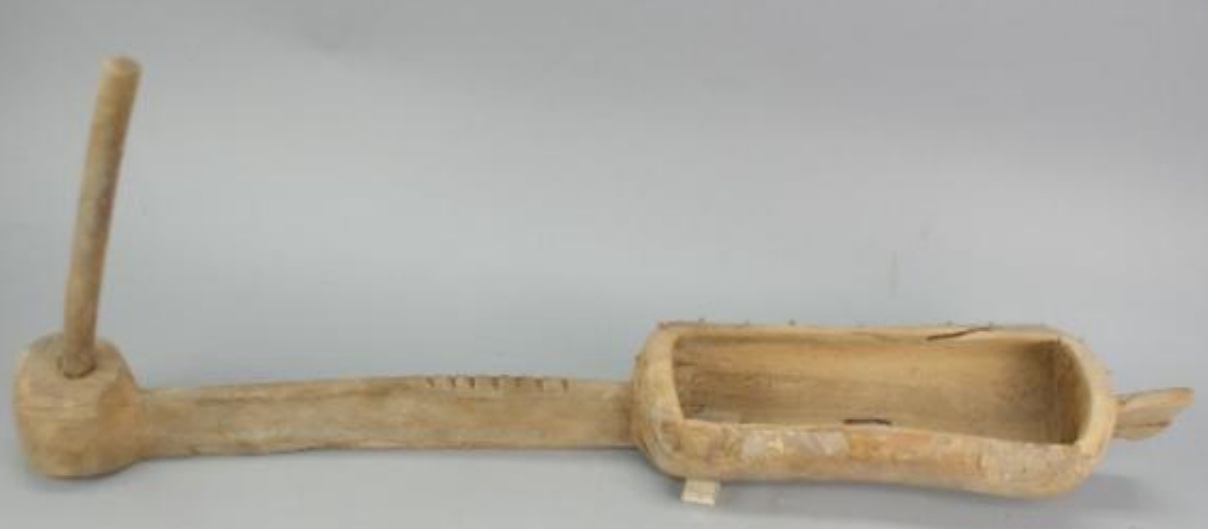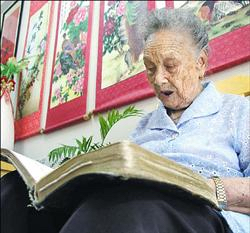Archive for Writing systems
Ya Zuo, a Russian-Chinese name
I'm at a big conference on Tang (618-907)-Song (960-1279) transitions that is being held at Princeton University. One of the participants was sporting a badge that announced her name as Ya Zuo. I told her that her name sounded unusual and wondered what kind of name it was. She happily volunteered, "It's Russian!"
I was perplexed, because she didn't look Russian (although appearances can be misleading: I've met Russians who look ethnically Korean, Chinese, Manchurian, etc., and the maternal great-grandfather of the preeminent Russian poet, Alexander Pushkin [1799-1837], was Major-General Abram Petrovich Gannibal, a nobleman of Sub-Saharan African origin). But we are at a conference where everyone is a China specialist, and I had heard Ya Zuo speaking some Mandarin. so I wracked my brain to figure out what characters were used to write her name, and was frustrated when I tried to figure out how it could be Russian.
Read the rest of this entry »
Biangbiang: authentic Xi'an grub in the heart of Philadelphia's University City
If you stand at the southwest corner of 40th and Chestnut in Philadelphia, this is what you'll see:
Read the rest of this entry »
A little Sinograph game
For cognoscenti.
Directions
Here's an amazing little game that was played by two of the brightest Sinology PhD candidates I've ever met. It is a conversation between X and Y. Y initiated the conversation by typing to X, without telling X the secret of the game. When X received Y's first message, she immediately got what Y meant. She understood as soon as she received his e-mail, then replied to him (by typing) in the same manner that he wrote to her. And so off they went on their merry way in Lexiland!
Here I copy-paste this little hànzì yóuxì 汉字游戏 for Language Log readers who are well-versed in Sinographs and want to give it a try. Even those who do not know any Chinese characters might still be able to gain a sense of how the game proceeds and what it signifies.
The "answer sheet” is at the bottom of this post. Please scroll down to the very, very end to see the answers. However, don’t look at the dá'àn 答案 ("solution") before trying really hard by yourself!
Warning!
This game is devilishly difficult.
Read the rest of this entry »
Further mystification of the Japanese writing system
"Baby Pikachu? Japan panel weighs accepting unconventional readings of kanji for names"
KYODO, STAFF REPORT
The Japan Times (May 19, 2022)
What’s in a name? In Japanese, that’s complicated. [VHM: You can say that again! One of the hardest tasks in my graduate training as a Sinologist was learning how to pronounce Japanese proper nouns correctly. This is one of the reasons I wrote the dictionary described in this post.]
An advisory body to the justice minister has compiled a draft proposal on whether and how to accept — and record on the family register — unconventional kanji readings of names for newborns and naturalized citizens. In one cited example of so-called kirakira (sparkly) names, it would be acceptable for the kanji characters 光宙 read as pikachū, which could be a hit for fans of the Pokemon universe.
The proposal is part of the ministry’s push for digitalization of the family register, an effort that would be better facilitated by adding hiragana and katakana readings to kanji names.
Read the rest of this entry »
Tarim harps; pitch, tones, scales, modes, instruments, and their names
[This is a guest post by Sara de Rose, responding to requests for more information on the subject prompted by her previous post.]
This post discusses a possible connection between the Mesopotamian tonal system, documented on cuneiform tablets that span over 1000 years (from 1800 BC to 500 BC), and the musical system of ancient China. For a more detailed discussion, see the paper "A Proposed Mesopotamian Origin for the Ancient Musical and Musico-Cosmological Systems of the West and China", Sino-Platonic Papers, 320 (December, 2021) written by myself, Sara de Rose.
Since 1996, twenty-three harps (Chinese: “konghou”) that resemble the angular harp that was invented in Mesopotamia circa 2000 BC have been found in the graves of the Tarim mummies, in Xinjiang Uyghur Autonomous Region, an area of modern-day, western China. These harps date from 1000 BC to 200 BC (see photo).
Read the rest of this entry »
Hangul: Joseon subservience to Ming China
[This is a guest post by Bob Ramsey]

In Joseon Korea, state agencies enthusiastically accepted their satellite position vis-à-vis Ming China. In fact, when King Sejong (1397-1450) revealed his new, non-Chinese writing system, the bureaucracy issued, in 1444, a blistering denunciation bordering on accusations of blasphemy:
“Our court, since the times of our founders and ancestors, has with utmost sincerity served the Great. We have uniformly honored Chinese institutions. But now, at this time of identical culture and identical standards, we create the Vernacular Script. We observe and attend this with alarm… If these graphs should flow into China, and if people there should adversely criticize them, how could we be without shame, considering our Service to the Great and our emulation of Chinese civilization!
Read the rest of this entry »
Tongji University's creative Sinographic design
Some amazing happenings at Shanghai's Tongji University, one of China's top institutions of higher learning. It seems that, as part of the general lockdown of Shanghai, the students — locked in their dorm rooms for weeks on end — have been suffering like everyone else. Not only do they lack sufficient food and water, the food that they are given is full of tapeworms and other such unwanted ingredients. So they complained on Weibo, WeChat, and other social media platforms. The authorities scrubbed and censored the complaints as fast as they could, but when things got out of hand, they decided to hold a large scale Zoom meeting with students, faculty, and administrators all together.
Then the students became really upset because the administrators not only did not reveal their true identities, they threatened students who complained with dire consequences. Whereupon some students hacked the Zoom meeting and spread it all over the internet, to the point that the government could not keep up with all the postings, postings that elicited the sympathy of the public at large.
Read the rest of this entry »
Character amnesia yet again: game (almost) over
Last week, I witnessed a palpable, powerful, poignant demonstration of tíbǐwàngzì 提筆忘字 ("forgetting how to write sinographs; character amnesia"). This happened in a colloquium where, during the discussion period, someone mentioned the standard eight-volume Historical Atlas of China (1982-1988) edited by the renowned geographer Tan Qixiang (1911-1992). A member of the gathering requested that the name be written on the whiteboard in sinographs. A colleague — a tenured professor of medieval Chinese history — popped up and said they could write the name in characters.
Already a little bit wobbly on the semantophore / radical on the left side of the first character (the surname), with a little bit of kibitzing from colleagues, the volunteer managed to produce the requisite semantophore after several false starts and erasures. After that great achievement (producing the semantophore amid much embarrassment), they turned to the phonophore on the right side but were getting nowhere fast, even with suggestions from colleagues who were looking on.
Finally, someone looked up the name on their phone and presto digito*, the correct writing emerged: 譚其驤 / 谭其骧 (the group — scholars all — collectively preferred the traditional form over the simplified one).
—–
[*VHM: I remember hearing this expression when I was young, but it barely exists on the internet, and I can't find it in dictionaries either.]
Read the rest of this entry »
Hokkien at UCLA, part 2
Referring to the first post in this series, "Hokkien at UCLA" (4/20/22), Chau Wu writes:
I totally agree with you about the Chinese prerequisite.
When I was younger (no, a lot younger) back in Taiwan, I had known a few grandmotherly Christian ladies who were illiterate in Sinitic script but perfectly at home in reading the Taiwanese Bible in Pe̍h-ōe-jī (POJ), i.e., Church Romanization (see below at * for further discussion). The following pictures appeared in the Taiwanese newspaper 自由時報 (Liberty Times) (Hokkien POJ Chū-iû-sî-pò; Hanyu Pinyin Zìyóu Shíbào) a few years ago about a Mrs. Lin (unrelated to any of the ladies I knew of) reading the Bible (Note the Bible shows signs of having been heavily used):
Read the rest of this entry »
New official night market sign with Taiwanese
The Shalu district of Taichung (Taizhong) is opening a new night market:
Read the rest of this entry »
Sumerian beer
There is a clear resemblance between the Sumerian and the Chinese glyphs for "beer", both of which depict a jug with a pointed bottom and an extended narrow neck (here, here). It's interesting that the oracle bone forms (second half of second millennium BC) for 酒 all have the three drops of water as a semantophore, whereas the bronze inscriptional forms (first millennium BC) and even some of the seal forms (latter part of the first millennium BC) lack the three dots for liquid, making the character for jiǔ 酒 identical to that for yǒu 酉 ("an ancient vase used in making and storing fermented millet liquors") — for all these forms, see here.
Wanting to investigate more deeply the Sumerian side of the equation, I asked my colleague, Philip Jones, a Sumerologist at the University of Pennsylvania Museum, for more information about the Sumerian word for beer, kaš. He replied:
Read the rest of this entry »
The Origin(s) of Writing
New article in the Wall Street Journal:
"‘The Greatest Invention’ Review: Written communication was a remarkable breakthrough, made in many different places and at different times." By Felipe Fernández-Armesto, WSJ (March 11, 2022)
There are a number of assumptions and speculations packed into just this title. When we look at the book itself, we find far more. In the wake of the sensationalism and hype over the recently published Kingdom of Characters, lauded in countless reviews, we need to take grand claims about the nature and purpose of writing with a great deal of caution and a pinch of salt. Fernández-Armesto's review is appropriately critical.
The review begins:
Theuth, the eager god, was proud of having invented writing. “It will,” he promised King Thamus, “make the Egyptians wiser and improve their memories.” Thamus, in Plato’s account of the myth, disagreed. “Your invention will make readers forgetful. They will stop trying to remember. They will absorb words without wisdom, data without learning, information without knowledge, and trivia without truth.”
The king’s criticisms eerily foreshadow current animadversions about the internet. Even when applied to writing, they were not entirely misplaced. Intellectuals should take them as a warning against overrating the scribe’s art. We tend to assume that the function of text is to perpetuate creativity, imagination and science. Really, however, writing began, in all the cases we know, by serving humdrum purposes: recording prices, inventories and tax returns. For most of the past, what was truly great was easily memorable: the epics, the myths, the revelations of the gods.
Read the rest of this entry »




